What do your first steps for Miles for Monarchs conservation look like? Are you stepping outdoors onto a porch? A deck? A stairwell? A stoop? Does your path lead you along city streets, through suburban neighborhoods, or down country lanes? Are you out before the sun rises, moving through the midday heat, or enjoying the twilight chorus? Do you travel alone, or accompanied? What are your chances of spotting a monarch on the wing or a late-generation caterpillar munching on milkweed?
Concrete stoops are not the first thing that comes to mind when thinking about wildlife habitat. Each day I step out the front door onto the concrete pad, one step down to the walkway that leads to the driveway and the sidewalk that runs through my suburban Colorado neighborhood. One afternoon in August of 2019 as I headed out for a walk, I realized I had forgotten something and retraced my steps. That stroke of serendipity shaped my journey with Wild Ones and showed me the truth behind the message: If you plant it, they will come.
I had stepped off the porch that day not noticing the beauty at my feet. Turning back, the vivid splash of orange was unmistakable. A monarch butterfly had emerged from its chrysalis sometime that morning and, relishing the residual radiant heat of the concrete stoop, had flexed and dried its wings.
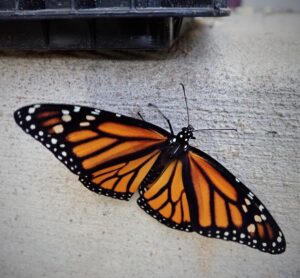
The butterfly dropped into the flat of swamp milkweed seedlings at the base of the stoop. These same seedlings had fed her and her siblings earlier in the month.
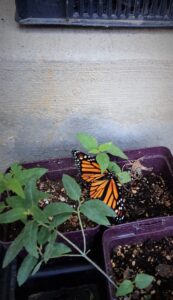
She paused for just a moment to get her bearings, and then took first flight, landing a few feet away in the front garden bed. For this monarch butterfly, that flight may have been the first leg on her long journey to central Mexico.
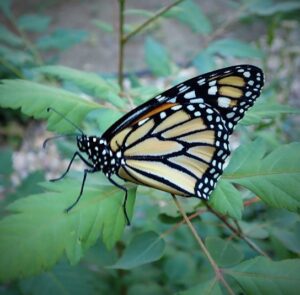
Communities along the base of Colorado’s Front Range are on the fringes of the monarch flyway and breeding ground. Monarch sightings in my neighborhood are rare. That summer, my front stoop was home to four dozen swamp milkweed plants, donated to my local Wild Ones Front Range Chapter by fellow member and zealous native plant propagator Arthur Clifford and offered to chapter event attendees. Between events, the plants, growing in 3.5” x 5” deep pots, lived in crates on my porch where they would be protected from hail. That protection from the elements must have appealed to mama monarch, who found the tender plants and laid her eggs on the undersides of the leaves. No blooms lured her to the site; the plants were in their first year and too young to flower. She laid as many eggs as the population of plants could support.

I did not notice the eggs. It never occurred to me to look for them. I first observed chewing damage on the leaves and, upon inspection, discovered a second instar and its shedded skin, shortly after molting.

Monarch caterpillars eat constantly, appearing to double in size daily and growing to almost 2,000 times their original mass through five larval instar stages. To learn more about the life cycle of monarchs, visit https://monarchjointventure.org/monarch-biology/life-cycle.
Once discovered, I checked on the caterpillars several times a day. At peak count, 17 caterpillars were feasting on these milkweed plants. I didn’t name the caterpillars, but I did grow quite attached.

Their front and back tentacles (also called filaments) and 16 legs (6 true legs and 10 prolegs) tickle as the caterpillars crawl along your skin. Their mouthparts (mandibles) got a workout as they chewed their way from plant to plant.

Nature brings both joy and heartbreak. Monarchs have many natural enemies. Fewer than one out of every ten eggs laid by a female monarch will survive to become an adult butterfly. What felt like a haven for these caterpillars, sheltered from wind and hail and somewhat protected from foraging birds, was not a safeguard against tachinid flies. These parasitic insects lay their eggs on monarch caterpillars and the tiny larvae feed on the caterpillars, eating them from the inside out and emerging just as the caterpillar reaches its pupal stage. I believed all the caterpillars had succumbed. What I did not know was that the caterpillars move off their host plants to pupate. I found the remains of the chrysalis belonging to the butterfly that survived hanging from a lip in the siding close to the front door about a foot off the ground.
Witnessing that first flight brought me hope. Mama monarch had also found and laid an egg on the leaves of another swamp milkweed plant growing in a 5-gallon nursery pot on my back deck, which is also covered and protected from hail. The caterpillar had gone missing, and I feared it had perished. Knowing that the caterpillars seek out a sheltered spot to pupate, I searched the deck, and to my delight found the maturing chrysalis hanging from the underside of a wooden bench.
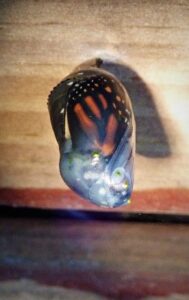
I checked on the chrysalis several times a day. When the monarch black and orange markings were clearly visible through the transparent cuticle, I set up a camera in the hope of capturing the butterfly’s emergence. I was not disappointed!

The chrysalis ruptured in the early afternoon, and the butterfly, another female, patiently waited for her body to dry before flexing her wings and venturing out into the sunlight.
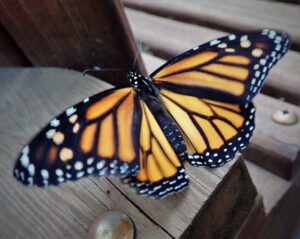
As dusk settled, the monarch alighted on a chokecherry sapling that the birds had planted, content to spend the nighttime hours disguised as a leaf. Come morning she had flown.

If you plant it, they will come. You don’t need a yard or garden to invite monarchs into your neighborhood. Swamp milkweed (Asclepias incarnata) is found in all but four of the lower 48 states according to the Biota of North America Program and is hardy to USDA Zone 3 (-40°F), making it a solid option for a deep container. A larger pot provides better insulation for the root zone and increases the chances for the plant to survive a harsh winter. Remember to water the pot a few times throughout the winter; while the plant is dormant, the roots need to stay hydrated. A swamp milkweed plant won’t want to live in a pot forever; after a few seasons consider gifting the plant to someone with a garden space and adopting or growing new plants from seed for your container garden. Connect with your local Wild Ones chapter to learn which milkweed species native to your area monarchs favor, and which species adapt well to container culture.
As you travel your Miles for Monarchs, do you see milkweed? Do you see monarchs? We must welcome milkweed into our landscapes if we want to see that delightful flash of orange against a bright blue sky.
About the author/photographer: Wild Ones Chapter Liaison Lisa Olsen is a member of Wild Ones Miles for Monarchs team and the Wild Ones Front Range Chapter.
